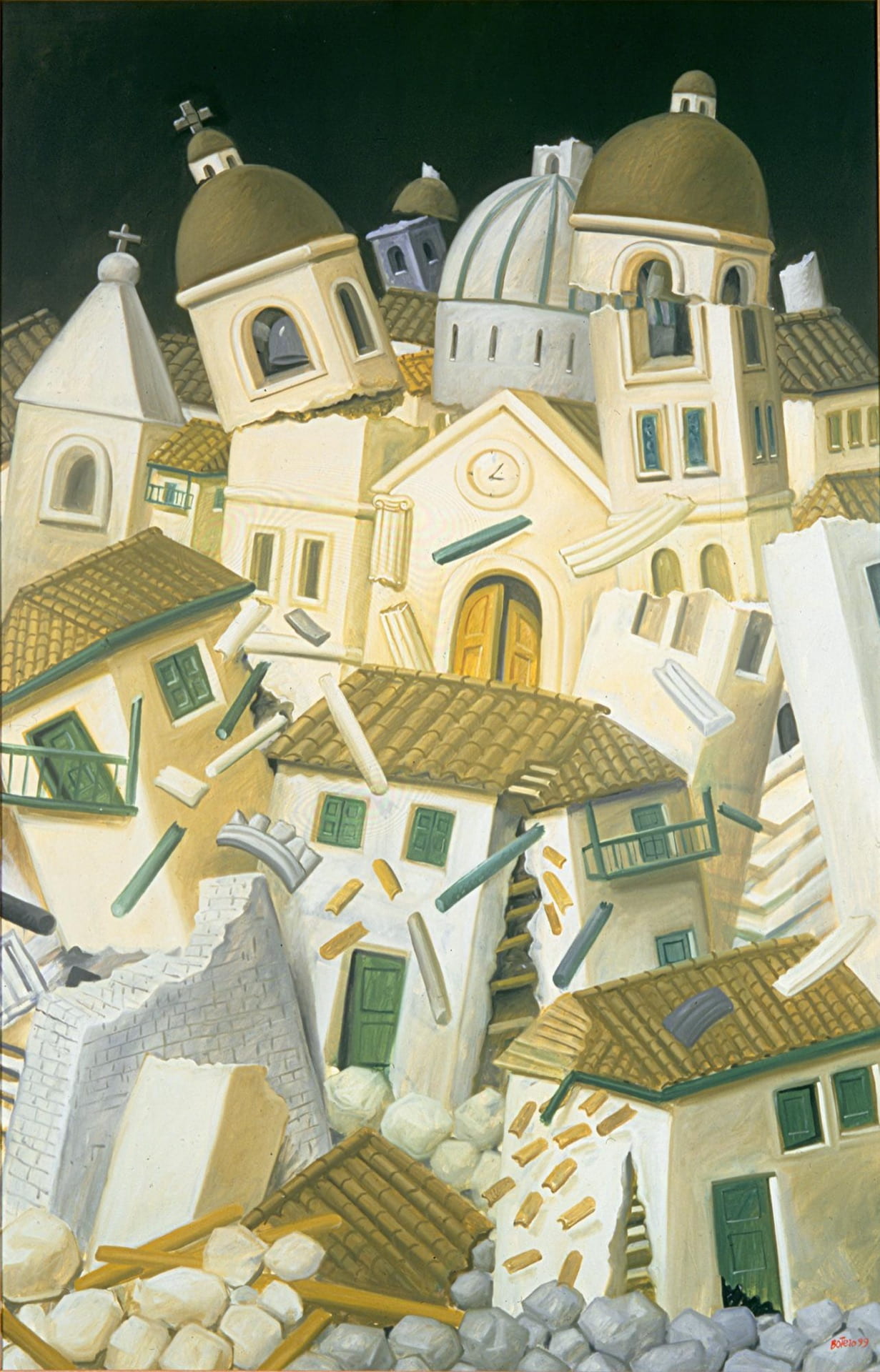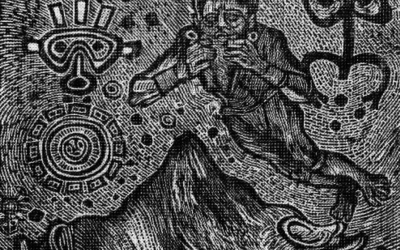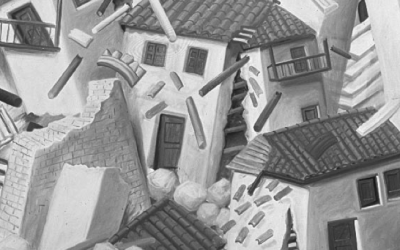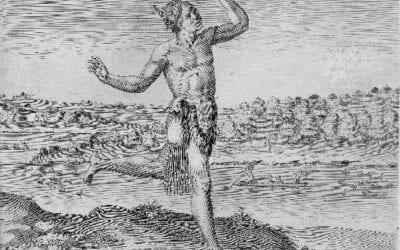Political Memory
Earthquakes During the Colonial Period
Late in 1717 Dr. Joseph Surin, precentor of the Cathedral of Old Guatemala, carried out some calculations: had the mudslide that wiped the city on the 28th of August, feast day of Saint Augustine of Hippo, constituted a sign from God? After all 28 was the result of 13 and 15. Wasn´t God trying to tell us that the Assumption of the Virgin Mary did not take place on the 15th, as ecclesiastical authorities claimed, but on the 13th as some unorthodox theologians argued? Dr. Surin´s words should not surprise us as he had started an account of the tragedy with the following words: “He looketh upon the earth, and maketh it tremble, He troubleth the mountains, and they smoke.” To him the origins of the volcanic eruption and related tremors did not constitute a mystery; their meaning did.
Noted critic and philosopher Raymond Williams claimed that “Nature is perhaps the most complex word in the language.” Its complexity responds to the tight interdependency and interplay of its meanings with what he called “one of the two or three most complicated words”: culture. These two concepts have defined our understanding of the modern period, characterized as the progressive emancipation of man from nature. Modernity seeks domination of nature as the ultimate goal, and progress seeks to expel nature from the domain of history. For the most part, this formula has succeeded in convincing us that nature has faded from the horizon. That is, until it erupts violently–through earthquakes, hurricanes, volcanic eruptions, floods, droughts or plagues—and reminds us that, after all, we are but small creatures in this world.
An approach to disasters in colonial Latin America must distinguish between natural events and natural disasters. Natural events may be destructive but they only become disastrous when they take human lives and disrupt the functioning of societies. A natural disaster, therefore, is the coincidence between violent natural events (say, seismic movements or high winds), conditions of social vulnerability (such as high levels of demographic density, inadequate construction standards or corrupted bureaucracies), and a moralistic perception of human suffering. This last element should not be forgotten as disasters are as much about material destruction as they are about symbolic devastation. Collective perception changes when destroyed buildings are emblematic (i.e. the Twin Towers) or “merely” humble shacks in a small, poor and remote outpost. Similarly, understandings of the events change substantially depending upon whether violent eruptions are perceived as a whim of the gods, a signaling the end and beginning of a new era, a random event in a meaningless world, the release of underground stress along fault lines; or simply, a terrible divine punishment. Economists, sociologists and political scientists study disasters to discern social and economic patterns, political arrangements and institutional responses. More recently, historians and cultural critics approach them to explore physical and social landscapes sealed from view (for instance, religious female cloisters) and investigate their belief and value systems.
Earthquakes play a significant role in the Americas, a land where “Heaven and Earth have spoken … often […,] a pleasant and unknown language which casts us into admiration and fear at the same time”, as Jesuit Jerome Lalemant wrote in 1663 in Quebec. They shape material and symbolic culture and forge local identities through dynamics of co-existence, response and reconstruction. Native American lore abounds with stories about their origins and meanings. The Huarochirí Manuscript—a collection of Andean myths—reads:
Regarding Pacha Cuychic, the World Shaker, this is what people said:
When he gets angry, earth trembles. When he turns his face sideways it quakes. Lest that happens he holds his face still. The world would end if he ever rolled over.
Native Andeans appeased seismic rumblings through appropriate rituals and offerings. Conversely, in various Guatemalan pre-Hispanic sites, archeologists found evidence linking the disappearance of the Mayan Empire to earthquake activity. Mexican codices record earthquakes as omens of the Spanish invasion.
Early European settlers responded to such unknown language by recording, commenting and even fictionalizing earthquakes. Spanish doctor Juan de Cardenas, author of Problemas y secretos maravillosos de las Indias (1591), justified their frequency and intensity by appealing to the New World´s marvelous nature. Municipal authorities in Lima and Caracas discouraged the construction of high level buildings while settlers in Almalonga, former capital of Guatemala, relocated to Antigua after a mudslide in 1541, moving again after the devastations of 1717 and 1773. In 1647, Chilean Indians and slaves took advantage of the ensuing chaos to conspire for their freedom. Earthquakes even prompted the appearance of the first newspaper in Santafé de Bogotá, when Don Antonio Espinosa de los Monteros published “Avisos del Terremoto” in August and September of 1785.
Earth movements have similarly influenced religious life. In Mexico earthquakes adopted the names of saints; in Guatemala and Arequipa they gave rise to nuns’ mystic visions; in Rio de Janeiro, Rosa Egipciaca, an African born slave widely regarded a saint, predicted in 1756 that the city would be destroyed, just like Lisbon the year before. Her unorthodox visions led to her arrest and trial at the Inquisition. In Cuzco the Taytacha de los temblores (Lord of the Earthquakes), the Andean Christ that serves as the city’s patron saint, continues to lead the main procession on Holy Week Monday in remembrance of the great destruction of 1650. Every October, since 1746, Lima residents display the Señor de los Milagros(Lord of the Miracles) in what is one of the largest religious processions in Latin America.
Earthquakes as manifestation of divine will bring a fundamentally different understanding of natural disasters than our secular view allows. Scientific theories explained earthquakes as caused by the gathering of air under earth and suggested preventive measures such as poking holes in the ground in order to release repressed air. Some colonial intellectuals even made fun of religious views: the Peruvian Juan del Valle y Caviedes, for instance, wrote the sonnet “Que los temblores no son castigo de Dios” (That Earthquakes are not Punishment from God) on the occasion of the 1687 Lima earthquake, “que nada de castigo en sí contienen; /pues si fueran los hombres sin pecado,/ terremotos tuvieran como hoy tienen.” (“Earthquakes are not punishment-filled; even if men were sinless, earthquakes would shake the earth as they do today.” In these accounts the word ´disaster¨ approaches its etymological meaning (dis astrum, from the stars) as it refers to a sign that originates in the heavenly realm, a semiotic model already present in the Bible—“When disaster comes to a city, [says the prophet Amos to the disobedient people of Israel] has not the Lord caused it?”(Amos 3:6). Thus, the author of the vivid “Individual and Truthful Account of the Extreme Ruin Experienced by Lima in 1746” acknowledged that “Amidst the horrors with which nature has shown itself as a manifestation of Divine Justice … the sudden jolt of earthquakes, at once warning and punishment, is the most dreadful.¨ In such view, social suffering is construed as the consequence of God’s just rage against man while earthquakes are a sign of the Divine presence among humans, an anticipation of Judgment Day.
Earthquake documentation allows us to understand three essential components to a disastrous experience. These documents reveal the collective sense of disaster, that is, the perception of how divine punishment disturbed social life. They specify the nature of the moral infraction, that is, the reason the earthquake was sent by God. And, finally, they animated their audience to repent and be part of the process of turning the world back upon its feet.
Collective perception of disasters often circulated in an image that synthesized social suffering by staging a world upside-down, a vivid representation of how natural violence led to social disintegration, particularly in terms of cherished basic social hierarchies. The author of the 1650 Relación del temblor que Dios Nuestro Señor fue servido de embiar à la ciudad de Cuzco declares that “… vino de repente un gran temblor, que todos salieron huyendo a las plaças, y calles, llenos de confusión, sin haber adonde acudir, pues ni el marido cuydava de su muger, ni la muger de sus hijos, sino cada cual procurando escapar la vida.” This allusion to a domestic life turned upside down – husbands disregarding their wives and mothers their sons– is a frequent one in natural disaster narratives.
Though colonial disasters level social distinctions and overpower local conventions, social suffering is never random: it is directed against those in society distinguished by their rank and position, understood to be morally in charge of the populace. Thus, it is not surprising that the earthquake´s destructive force is best portrayed by representations in which their violence is directed against infamous authorities and notables. An illustrative example is that of Beatriz de la Cueva, conquistador Pedro de Alvarado´s widow, who in 1541 forced the local cabildo (municipality) to name her governor. Her arrogance, excessive ambition and disorderly conduct presumably led to an ensuing catastrophe. Several accounts show Beatriz in agony, begging for forgiveness and locked in an oratory with twelve ladies in waiting, at the mercy of an imminent and deadly mudslide.
The hermeneutical task of witnesses, informants and commentators consisted in elucidating how such extraordinary and cruel social suffering fit the preordained script for human events. Visual and written documents evince an anxious desire to discern the meaning of material destruction; smoke and ruins are but the spatial cipher of God´s will. Thus, it is not surprising we find learned men debating the significance of dates, scrutinizing the wreckage, chronicling the fate of preeminent victims, and repeating, in amazement, stories of miraculous deliverances.
The examination leads to an obsessive listing sins perpetrated by locals dwellers—homicide, the nefarious sin (homosexuality), greed, stealing, sacrilege, vanity and rebelliousness—that as a consequence led an otherwise benevolent God exert such cruel means. These accounts reveal divine designs and instruct audiences on restoring the moral balance within the polis—through repentance and penitence. The overwhelming majority of these documents—from official reports, epistolary exchanges and panegyrics to sermons, novenas, admonitions, exemplary histories and eulogies—and visual artifacts (such as the painting commissioned by Don Alonso Cortés de Monroy found in Cuzco´s Cathedral) had a specific social life which animated or even accompanied collective performances. Furthermore, these actions, exemplified by the ever present massive public processions, endeavored to right the world by seeking reconciliation with God.
However, natural disasters cannot be solely understood in the context of religious drama. Once the imminent danger passes, these societies, fearful still, initiate a process of response, rebuilding and adjustments that cannot be reduced to religious language. A cogent approach to natural disasters must take into account local contexts, particularly, the struggles that defined political cultures and the variety of representations produced in the wake of the event. Allow me to discuss two such cases.
LIMA 1746
At 10:30 p.m. on October 28, 1746, a massive earthquake struck the coast of Peru with such force that it flattened Lima, damaging most of its ecclesiastic and civic constructions, and setting off a tsunami that swamped Callao. Estimates of the number of dead range up to 10,000, out of an approximate population of 60,000 in what the preface to “A True and Particular Relation …” called “one of the most dreadful, perhaps, that ever befel this Earth since the general Deluge.” Archives overflow with traditional sermons and clerical admonitions, though modern scientific approaches were changing the way disasters were perceived and responded to. From the outset local reports indicated slaves and the plebs seized the occasion to loot and rebel and expressed concerned about their licentious behavior, a situation further aggravated by the decade long revolt by Juan Santos Atahualpa.
The physical and symbolic reconstruction of Lima, the economic and political hub of South America, takes place in the context of a siege mentality. The morning after, the Vicerroy Manso de Velasco organized several militias and sent them out to protect important buildings in Lima and the desolated port of Callao, setting up gallows in both cities to discourage any further ransacking. He requested French cosmographer Louis Godin, who went to Peru with La Condamine, to design a new portentous fortress for Callao and Lima and he drew on Jesuit José Eusebio de Llano y Zapata, Pablo de Olavide and other notable individuals to fortify weakened constructions, re-organize the city, and take other measures that would restore control and strengthen authority in the face of what they perceived to be the threat from a growing plebeian and multiracial society.
Parallel to this strengthening of royal authority, the local elite soon began to transform desolation into signs of resilience by portraying Lima as a rising Phoenix, emerging from the ashes more glorious than ever. Poets, clergy and bureaucrats tapped on a longstanding Peruvian literary tradition that poeticized such “materia …esteril” (sterile subject), as Pedro de Oña dubbed it in 1609. In the resulting odes, casual bards reminisce about the old city and lament the fate of beloved ones, but also pay tribute to authorities and lavish praise on the new emerging city. They are elegies that work as eulogies.
Restituting Lima to its deserving fame proved as important as rebuilding the city. The author of “Desolation of the City of Lima and Deluge of Cuzco” (1746) entreats local inhabitants to be frugal in their expenses to ensure that in twenty five years the new city will be “… more beautiful … and safer than the one we have lost”. Twenty-five years after the earthquake Felipe Colmenares Fernández published The Desired Day (1771), an account describing the festivities accompanying the inauguration of the Nazarene Church. The splendid church was designed to host the revered image of the Santo Cristo de los Milagros, Lima´s patron saint and protector against earthquakes. Local elites could finally claim Lima once again had attained a preferential regard in God´s eyes. If frequent recurrence of earthquakes made Lima “the most licentious spot upon earth”, as the British translator of the 1746 account remarked, the city´s resurgence and flourishing made it the most resilient and spiritually devoted.
CARACAS 1812
The earthquake of Lisbon in 1755 revealed that natural disasters no longer had to be explained as a manifestation of God’s paradoxical benevolence. However, the Caracas earthquake of 1812, which took place in the midst of the struggles for Spanish American Independence, demonstrated the appeal such narratives still had for a great number of people.
In 1808 Napoleon invaded Spain and forced King Ferdinand VII to resign. Most Spaniards and Americans rebelled against the French and set up a provisional Supreme Governing Junta. However, as the war in Spain worsened, American elites—including the Caracas Cabildo (municipality) decided to resume sovereignty on April of 1810. A political rift ensued between those who remained loyal to the faltering Spanish Junta and those in favor of an autonomist position.
The next couple of years display intense political struggle as young revolutionaries rehearsed various political formulas. However, on Holy Thursday of 1812, a horrific quake rattled the region and seemed to put an end to these republican experiments. It killed more than 10.000 people out of a total population of 40.000, destroying Merida and Guaira as well. Patriot commentators wrote the earthquake sealed the fate against liberty as the city fell again to Spanish pro-Junta forces two months after devastation.
The Caracas earthquake caught the interest of few commentators. From Philadelphia, Jonathan Plummer, a self proclaimed missionary, physic and poet, stated the earthquake was the just punishment to those patriots who read Thomas Paine´s political pamphlets. Louis Delpech, a French official stationed in Caracas, carried on ethnographic descriptions for his French newspaper, the Journal de Paris, by describing the extreme callousness of Spanish Americans: “I saw parents who had lost five and six children, friends who had lost all their possessions, without shedding a tear. Most were comforted by speaking to an image of the Virgin or of a favorite Saint. Others happily drowned their sorrow with rum ….” Latter still, Richard Longeville Vowell, British officer in Caracas, later wrote a novel in which a Native chief saved a noble young White American couple from fanatic monks who incited the mob against them for their republican beliefs.
Like Plummer, the Archbishop of Caracas, staunch Spanish royalist, claimed the earthquake was a sure sign of God`s anger. Since it happened on Holy Thursday, two years after Caracas separated from the Spanish Junta and a year later after the Venezuelan Constitutional Congress convened, the earthquake was but another Biblical recurrence of the fury unleashed on sinful cities. Venezuelans, according to the Archbishop, incurred in two major offenses: non-elite Venezuelans allowed themselves to be deceived by the young revolutionary elite while the arrogance of the latter led them to disown Spain, America´s natural mother. Only Monteverde, the Spanish officer in charge of re-conquering Caracas, could restore the tutelage of the natural mother and put an end to these “imaginary republics.”
Conversely, Creole patriots insisted on the non-religious nature of the event. To them the earthquake was both materially damaging and symbolically devastating, for it only served to be narrated as punishment from God and as an apt metaphor for the difficulties faced by young patriots in giving political form to such variegated nation. In spite of the difficulties, Bolivar proudly claimed, standing atop the wreck, that “if nature opposes us we will fight against her and force her to obey us.” From the revolutionaries´ perspective such claims demystified clerical discourse, but for many Catholics they only confirmed their arrogance and illegitimacy. Furthermore, as the utterance subordinates the natural order to a unified will, this famous allocution (repeated in 2005 by the ambassador of Venezuela to the OAS in the aftermath of Katrina’s tragedy) must be understood in its double signification. On the one hand, it is an ironic response to the accusation leveled by Royalists; on the other, it reveals a clear consciousness of the task ahead: Nation-building is a historical construction requiring engagement –and often times subjugation— of those social groups (blacks, mulattoes, mestizos and Native Americans) who do not conceive themselves as being part of an independent Venezuelan Republic.
In both the cases of Lima and Caracas, existing documentation provides an accurate portrayal of elites responding to extreme social emergencies. However, in both cases, the proliferation of local elite discourse drowns subaltern perceptions of the earthquake. The actions of some Native Andeans, slaves and free blacks in the wake of these disasters highlight budding social antagonisms at the core of colonial society. Their actions speak of conflict and agony rather than self-assurance or arrogance. Dare we say that for some of them the earthquake did not bring about a disaster but an opportunity to rid themselves of degrading conditions? How do we otherwise understand the crew of blacks who rode at night into Lima few days after the earthquake spreading the rumor of a second tsunami and looting the houses deserted by their terrified white inhabitants? Furthermore, what shall we say about the enormous popularity gained by the procession of the Señor de los Milagros after October of 1746, particularly as one remembers such black Christ (Cristo moreno) had longstanding connections to both Native Andean and black communities? Did 1812 constituted a disaster for black slaves in Venezuela or an opportunity to escape their owners, many of whom were fervent revolutionaries? And could we say their vehement opposition to the republican experiment illustrated their ignorance –as Bolivar argued– or had something to do with the news arriving from Saint Domingue, a land where republican freedom meant the destruction of the plantation system?
Winter 2007, Volume VI, Number 2
Francisco A. Ortega, director of the Center for Social Studies (CES) and Associate Professor at the History Department of the Universidad Nacional in Bogotá, Colombia. He was a Visiting Scholar and Teaching Assistant at Harvard’s Romance Languages and Literatures from 1995 to 1999 and one of the founders of the Colombian Colloquium at Harvard in 1997.
Related Articles
Editor’s Letter: Natural Disasters
We were little black cats with white whiskers and long tails. One musical number from my one and only dance performance—in the fifth grade—has always stuck in my head. It was called “Hernando’s Hideaway,” a rhythm I was told was a tango from a faraway place called Argentina.
After the Earthquake: Juan’s Life
Juan was a construction helper. He lived in Armenia, but his parents were from the Antioquia region, who had fled because of the violence there. The mother of his children was called…
Environmental Stress and Rainmaking
When Europeans first attempted to settle in North America north of the Rio Grande, their confrontations with Indian cultures were marked by cosmic struggles over environmental…





